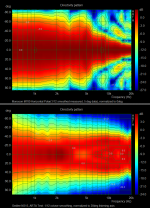Have been using the 700 planars as mids for about a year now. Lovely for mids active minidsp
My Monsoon-midded monsters sound terrific! They're only doing 238 to 1,980Hz (LR4 with a DCX 2496) so they're not asked to do too much.
Attachments
I don't understand the reason for your post.
Thanks.
I'm still a bit puzzled by the CSD... looks quite different from the BG Neo8, which decays quite rapidly.
I am surprised to see no hint of a cavity resonance which is pretty much a "feature" of all push-pull magnetic planars. Is the 5dB EQ you mention hiding it perhaps?
I’d be interested to see a near field and/or 1m measurement without the EQ in place if you have the time and interest.
I had the opportunity to measure some M700s last weekend. Enjoy!
Attachment #1: Polar response data was measured @ 1.5m with a 4mS window. You can see that the M700 does have a cavity resonance like most push-pull magnetic planars.
Attachment #2: Compared to the BG Neo8, the cavity resonance isn’t as pronounced(due to the higher %open area of the plates) but is a bit lower in frequency
Attachment #3: The 30deg off-axis data seems to line up pretty well with response data posted at the beginning of this thread. Perhaps that is why the cavity resonance wasn’t noticeable.
Attachment #4: CSD plots for on-axis and 30deg off-axis looks very similar to what I had seen with the Ne08. Not sure what the cause of the hashy CSDs posted at the beginning of this thread.
Attachment #5: Polar map using data measured every 5deg, compared with theoretical polar response for an ideal rectangular piston.
If interested in theory, see:
Vertical dispersion on planars. How much?
Attachment #6: Polar map using data measured every 5deg, compared with theoretical polar response for an ideal rectangular piston adding diffraction from the metal frame using BTM diffraction method. Including the diffraction calculations does a surprisingly good job of matching the features of the measured polar map.
If interested in BTM diffraction method, see:
Baffle edge diffraction with dipole radiation
Attachments
-
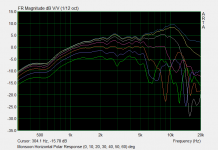 Monsson_M700_response.png25.6 KB · Views: 388
Monsson_M700_response.png25.6 KB · Views: 388 -
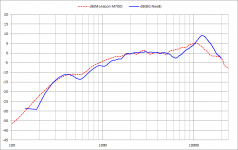 Monsson_M700_vs_Neo8.png37.2 KB · Views: 381
Monsson_M700_vs_Neo8.png37.2 KB · Views: 381 -
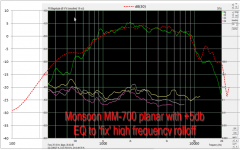 Monsson_M700_30deg_compare.png156.1 KB · Views: 352
Monsson_M700_30deg_compare.png156.1 KB · Views: 352 -
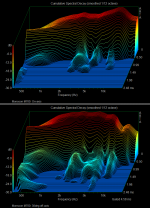 Monsson_M700_CSDs.png125.4 KB · Views: 347
Monsson_M700_CSDs.png125.4 KB · Views: 347 -
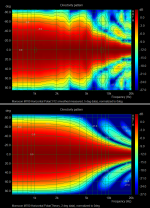 Monsson_M700_Polar_vs_sinc.png184.1 KB · Views: 341
Monsson_M700_Polar_vs_sinc.png184.1 KB · Views: 341 -
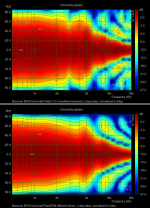 Monsson_M700_Polar_vs_BTMdiffration.png196 KB · Views: 97
Monsson_M700_Polar_vs_BTMdiffration.png196 KB · Views: 97
Bolserst's plots look really good. And that colour waterfall illustration is a Tufte-worthy meaningful display, even if the results are only so-so.
I'm not sure how to understand polar plots. You can't hear beaming. You hear what gets to your seat. That is a combination of direct sound and bounced sound and time course (and your taste in sound too). Just because a polar plot is horrible doesn't mean the sound at your seat is bad.
If you follow the Geddes argument, you'd want stringent control of the direct sound propagation (like using his waveguide treble). That way the bouncing sound is better controlled and so you know what you are getting at your seat from knowing the direct FR.
But starting with planar drivers, you can see how Patrick Bateman and some manufacturers are trying to sort out this problem.... if it is a problem?
B.
I'm not sure how to understand polar plots. You can't hear beaming. You hear what gets to your seat. That is a combination of direct sound and bounced sound and time course (and your taste in sound too). Just because a polar plot is horrible doesn't mean the sound at your seat is bad.
If you follow the Geddes argument, you'd want stringent control of the direct sound propagation (like using his waveguide treble). That way the bouncing sound is better controlled and so you know what you are getting at your seat from knowing the direct FR.
But starting with planar drivers, you can see how Patrick Bateman and some manufacturers are trying to sort out this problem.... if it is a problem?
B.
Last edited:
The polar plot displays at a glance the response at all radiation angles relative to each other. This allows better understanding of the tonal balance of the sound getting to your seat directly, and via room reflections. If the source has non-uniform coverage or uneven response off-axis(and you aren’t listening in an anechoic chamber) it will affect what you hear at your seat in a negative way. You might consider revisiting Part 2 of the Toole book. Also, as we’ve discussed in other threads, if the beaming is excessive like with 12” wide ESLs, you will also have to deal with the issue of small head movements changing the tonal balance. I don’t think the M700s fall in that category, although they would need to be aimed at the listening position and would not be good for sharing a movie soundtrack with the family on a couch.…I'm not sure how to understand polar plots. You can't hear beaming. You hear what gets to your seat…
Beaming from large, flat, uniformly driven radiators result in directivity increasing progressively with increasing frequency. This is not controlling the direct sound in the manner that Geddes recommends. In fact when I have shared data for ESLs with polar maps like this his response has been …”why would anybody design a loudspeaker like that?” Attached is a comparison with the Geddes NS15(New Summa). You can see that the NS15 has nearly uniform coverage over the +/-45deg wave guide angle. Beyond that, the frequency response continues to stay flat, just reducing in level.If you follow the Geddes argument, you'd want stringent control of the direct sound propagation (like using his waveguide treble).
If I remember correctly, Patrick Bateman owns a pair of the original Summa.
So he would be in a good position to comment on the polar response comparison.
Attachments
Last edited:
Glad to hear you found the measurements useful.…I've been looking for that type of measurement for a long time. I'm looking at using 9 or 10 in a line source with a Magnepan ribbon tweeter after completing a few other projects first.
Your project sounds like fun. Where are you sourcing all those Monsoon drivers from?
If the source has non-uniform coverage or uneven response off-axis(and you aren’t listening in an anechoic chamber) it will affect what you hear at your seat in a negative way.
I suspect people are no more sensible of beaming than of comb filtering. I think the problem is that hearing is insufficiently viewed in what psychologists refer to as a Helmholtzian point of view (an "unconscious inference" as he put it, or a mental construction leading to what you might think of as a synthesized conscious experience).
While nobody would quibble about simple polar traces representing the speaker output, I think the perceptual reality to human ears is the real question (and I hope nobody would quibble about that either). The net result for the listener remains the issue. It may be that a speaker with horrible polar plot but comparable total power may not sound inferior to one with a great dome-driver polar plot (various other things comparable, of course).
Returning to the physics of the situation, I suspect sitting in the main beam - mostly pretty wide for the majority of sound that matters (ignoring the trivial content above maybe 10kHz) - makes the sound pretty good. And makes being anxious about beaming a non-issue.
B.
Last edited:
Total radiated power vs frequency and Polar plots are interrelated, so speaker with horrible polar plot has horrible radiated power also. The problem is that you need many polar plots vs frequency. On the other hand, total radiated power is easy to measure.It may be that a speaker with horrible polar plot but comparable total power may not sound inferior to one with a great dome-driver polar plot
I would like to hear more about the importance of response above 10k. Anyone have any links to testing done on this??
and in reply to audiomagnate too,
what could be simpler than to rig your system to play only the upper treble for you. Anything there? There is the opposite test of including or excluding upper treble but may not mean much unless done ABX*.
Or in a few minutes, set up REW to do a real-time analysis of some pieces of music.
Ummm, took a moment to decide what kHz I would post. Probably 9kHz would have sounded too provocative even if that is what I believe.
Here's how I tell how my treble is doing: Holst's Band Suites has an "orchestral anvil" in the - you guessed it - "Song of the Blacksmith" band 7. If it sounds like a triangle rather than an anvil, the treble is off.
Anybody know of another piece of music with an anvil?
B.
*maybe blind isn't critical; after all, if you have much trouble telling apart that speaks for itself
I hear ya. Ive chased this crudely for some time and I too wonder about all the fuss on extended response.
Even when I was younger and could hear 20k I played a bit with cutting info above 10k and I was surprised. afraid to admit it ha
Would like to read any testing done though
I admit with some testing done on ribbons ranging from 4 micron to 20 micron thick that yes for sure the rolled off highs of the heavy weight stuff seemed important but further testing leads me to believe that the idea that "if it can do 30k it will do everything else below better" line of reasoning is simply not so.
Even when I was younger and could hear 20k I played a bit with cutting info above 10k and I was surprised. afraid to admit it ha
Would like to read any testing done though
I admit with some testing done on ribbons ranging from 4 micron to 20 micron thick that yes for sure the rolled off highs of the heavy weight stuff seemed important but further testing leads me to believe that the idea that "if it can do 30k it will do everything else below better" line of reasoning is simply not so.
Last edited:
Hi BolerstGlad to hear you found the measurements useful.
Your project sounds like fun. Where are you sourcing all those Monsoon drivers from?
I bought a lot of them years ago when Monsoon went out of business and the remaining stock started turning up at surplus dealers. They reminded me of the Infinity drivers that were in the RS1B I had back in 1989 and I thought they may come in handy for a future project. I also bought up about 40 of the Pioneer ART57D ribbon tweeter and also the Panasonic leaf tweeter around the same time.
When you measured the MM700 was the driver out of the Plastic grill/stand? Also was the felt damping on the back of the driver in place?
Just so everyone knows there a three different types of Monsoon driver in this general configuration. The first generation is in the MM-1000 , the second in the MM-700 ( straight sides) and the third in the MM-702 (wavy sides) this is the version that VMPS used in their speakers.
Andrew
and in reply to audiomagnate too,
what could be simpler than to rig your system to play only the upper treble for you. Anything there? There is the opposite test of including or excluding upper treble but may not mean much unless done ABX*.
Or in a few minutes, set up REW to do a real-time analysis of some pieces of music.
Ummm, took a moment to decide what kHz I would post. Probably 9kHz would have sounded too provocative even if that is what I believe.
Here's how I tell how my treble is doing: Holst's Band Suites has an "orchestral anvil" in the - you guessed it - "Song of the Blacksmith" band 7. If it sounds like a triangle rather than an anvil, the treble is off.
Anybody know of another piece of music with an anvil?
B.
*maybe blind isn't critical; after all, if you have much trouble telling apart that speaks for itself
I'm guessing by your sig you're over 80. I'm not at all surprised that response over 10K is not important to you.
I use six MM702's per side from 235 to 2K. Very nice from about twelve feet away or more.Hi Bolerst
I bought a lot of them years ago when Monsoon went out of business and the remaining stock started turning up at surplus dealers. They reminded me of the Infinity drivers that were in the RS1B I had back in 1989 and I thought they may come in handy for a future project. I also bought up about 40 of the Pioneer ART57D ribbon tweeter and also the Panasonic leaf tweeter around the same time.
When you measured the MM700 was the driver out of the Plastic grill/stand? Also was the felt damping on the back of the driver in place?
Just so everyone knows there a three different types of Monsoon driver in this general configuration. The first generation is in the MM-1000 , the second in the MM-700 ( straight sides) and the third in the MM-702 (wavy sides) this is the version that VMPS used in their speakers.
Andrew
I'm guessing by your sig you're over 80. I'm not at all surprised that response over 10K is not important to you.
I am not surprised that your manners are as poor as your knowledge of hearing. You mistake average hearing for individual hearing under your urge to be disparaging.
And you don't seem to know anything about the frequency range of musical instruments.
B.
- Status
- This old topic is closed. If you want to reopen this topic, contact a moderator using the "Report Post" button.
- Home
- Loudspeakers
- Planars & Exotics
- Monsoon - Surprisingly Good!
![20170509_203458[1].jpg](/community/data/attachments/569/569006-dcbbef11a9126f2046f4a21d229bd13b.jpg)
